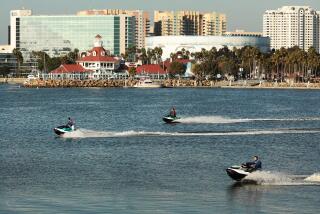Marathon Man : Long Beach’s Joe Carlson Races Clock, Setting Stage for 3,600 Runners in Hometown’s Footrace on Sunday
- Share via
LONG BEACH — A man with the lean, veiny look of a runner sat in a small, square room in a storage building near Signal Hill and reached for his ringing telephone.
“Long Beach Marathon,” answered Joe Carlson as he stared at names of runners on a green computer screen.
There was a brief conversation about T-shirt sizes. As soon as Carlson hung up, the phone rang again, as he expected.
Carlson, a marathon man himself, was getting ready for the race. But not to run in it--he’s too busy for that.
A 32-year-old who favors blue jeans, Carlson is the director of the marathon that is expected to attract 3,600 runners, walkers and wheelchair racers to the starting line at the Long Beach Convention Center at 7:20 a.m. Sunday.
Dozens of Gray Pipes
Through the race headquarters’ only window Carlson could see, stacked against a fence, dozens of exotic-looking gray pipes with nozzles.
The pipes will be assembled into spray stations, which will emit refreshing mist on the passing runners.
“When I ran the Palos Verdes Marathon in 1969, people used hoses on us,” Carlson said. “We had to slop around in wet shoes and get blisters.”
Next to the pipes, 1,700 orange highway cones waited to be hauled in Sunday’s pre-dawn darkness to the 26.2-mile course where they will be placed to guide the runners. (See course map on Sports Roundup Page.)
In the office, 16,000 safety pins Carlson had ordered sat in boxes on a shelf. It takes four pins to secure a race number to a runner’s shirt.
The Long Beach race is the largest marathon in Southern California, Carlson said, and its field of runners has increased each year. There were 1,600 in the first marathon in 1982, 2,400 in 1983 and 3,200 last year.
Carlson was on the phone again. He had dialed this time.
“ABC Sign Co.? Hi.
“How much is it?
“How’s it look?”
He hung up and said, “Our banners are finished,” to his assistant, Lynne Driscoll, who was worrying about the price to charge for coffee for runners’ families.
Driscoll answered the next call and told Carlson, “It’s the guy who runs backward.”
Carlson wondered whether Al Freese, the backward runner, would run into people. He took the phone.
“Al, are you able to turn around much? Do you have one of those bicycle mirrors?”
“He’s easygoing, he handles people beautifully,” Driscoll said of Carlson. “He has such patience. The runners are always calling, telling him their whole histories, how they got shinsplints. I’ve never seen him lose control.”
But Carlson, who finds only fleeting moments to spend with his wife and child as the race approaches, said, “I’m wrecking myself on this race. Yikes.”
He never shows it.
“It’s a little bit smoother this year,” said Carlson, who is in his second year as race director, a full-time, year-around job he was appointed to by the marathon’s board of governors. “But I don’t know if it’s because I’m more organized or because I can handle stress better,” he said.
A volunteer--one of 1,200 Carlson directs and coordinates--squeezed in for attention between phone calls and told Carlson she could get 500 doughnuts for $99.22, although she was concerned they might get hard and crusty before race day.
Multitude of Duties
“There are a billion things you have to handle along the sides,” Carlson said.
“But the most important thing is to get runners from the start to the finish and service them during the race. If you don’t do that, everything else is for naught.”
“We’ve been noted for our organization. Our purpose is to put on a race the runners will regard as the best they’ve run in.”
Carlson wants to make sure that (a) runners are directed correctly along the course, (b) aid stations don’t run out of water, (c) runners are given their times at each mile marker, (d) there are enough T-shirts and refreshments, and (e) the race starts on time.
“There’s joy in seeing runners have their best performance because of something we put together,” Carlson said.
Carlson started running 20 years ago when it wasn’t fashionable, when distance running was called cross-country and the participants wore white T-shirts and gym shorts and could remember the brand of their shoes only by looking down at them.
He ran cross-country and track at St. John Bosco High School in Bellflower, then at Long Beach City College and Cal State Long Beach. He later coached at those colleges and when the running boom of the late ‘70s hit, he became part-owner of a running shoe store in Long Beach, headed a running club and directed some races.
“As time went on, running became my life style,” Carlson said. “One of those positive-addiction things.”
He said he has run in 60 marathons, including Boston and New York.
Runs 55 Miles a Week
Best time? “2:18.41 in ‘79,” he said, snapping his fingers. The marathon record is only about 11 minutes faster.
Carlson said he runs 55 to 60 miles a week through his Long Beach neighborhood.
“I’d love to be running Sunday,” he said. “It’s kind of a drag watching everybody take off.”
But that feeling won’t last long.
“Being a hometown boy, there is satisfaction in doing something for the community,” Carlson said. Then he turned his attention back to 20,000 cups, 700 gallons of water and 700 gallons of a Gatorade-type drink that will be distributed among aid stations placed every 2 1/2 miles on the course.
“There is a misconception about races that all kinds of money is made,” Carlson said.
However, the Long Beach Marathon had a surplus of $4,000 after last year’s event, Carlson said. The money was distributed to area high school and college cross-country teams.
Major expenses include about $12,000 to the Long Beach Police Department, $27,000 for T-shirts, $32,000 for promotion and advertising, $17,000 for printing, as well as $41,000 for administrative costs that include Carlson’s undisclosed salary. There are is also $19,000 for equipment and facilities; Those highway cones are $6.50 each, and there are trash cans, coolers, rope and 900 sponges to purchase.
The marathon board, a nonprofit corporation, depends on sponsors for most of its money. Other sources include a Committee of 26, consisting of businesses and community organizations, each of which contributes $1,500 a year, and the 385 Club, whose members donate a minimum of $385. Runners pay a $15 entry fee.
There is no prize money, which is why the most well-known of the nation’s marathoners do not compete, Carlson said.
94% Finish Race
Since the inception of the race, 94% of the runners have finished.
“Running 26 miles is easy,” Carlson insisted. “It is a fun and enjoyable experience.”
The terrible look of many runners when they cross the finish line makes that hard to believe.
“You can run to the point of being wrecked,” Carlson said, “but a couple of hours and a couple of beers later, you’re OK.”
And then the accomplishment sinks in.
“You feel you can do a lot of things because you can run 26 miles,” Carlson said. “You are less intimidated by challenge because you have met the highest standard of running. You can talk to the boss you were afraid to talk to, or make the financial deal you were intimidated by in the past.”
It was 5 p.m. and Carlson was attending a meeting.
“You need cans of spray paint--flat black--to paint these (‘Left Turn Only’) signs,” a policeman told Carlson. “And you need staple guns to staple the signs to the barricades. And you need . . ..”
Carlson didn’t look the least bit intimidated.
LONG BEACH MARATHON FACTS AND FIGURES:
Date Feb. 3 Length 26.2 miles Starting Times: Walkers 7:20 a.m. Wheelchairs 7:25 a.m. Runners 7:30 a.m. Start/Finish Convention Center Plaza Sanction Certified by The Athletic Congress Divisions 16 individual, plus 2 team Aid Stations Every 2.5 miles on course Timing Called out every mile Digital clocks each 5 miles
FACTS: 33% of all participants are entered in a marathon for the first time. 66% will be 25-44 years old. 78% of all entrants will be males. 94% will finish the course. Source --Long Beach Marathon
More to Read
Go beyond the scoreboard
Get the latest on L.A.'s teams in the daily Sports Report newsletter.
You may occasionally receive promotional content from the Los Angeles Times.










